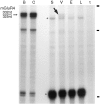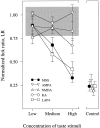The taste of monosodium glutamate: membrane receptors in taste buds
- PMID: 8656276
- PMCID: PMC6578609
- DOI: 10.1523/JNEUROSCI.16-12-03817.1996
The taste of monosodium glutamate: membrane receptors in taste buds
Abstract
Receptor proteins for photoreception have been studied for several decades. More recently, putative receptors for olfaction have been isolated and characterized. In contrast, no receptors for taste have been identified yet by molecular cloning. This report describes experiments aimed at identifying a receptor responsible for the taste of monosodium glutamate (MSG). Using reverse transcriptase (RT)-PCR, we found that several ionotropic glutamate receptors are present in rat lingual tissues. However, these receptors also could be detected in lingual tissue devoid of taste buds. On the other hand, RT-PCR and RNase protection assays indicated that a G-protein-coupled metabotropic glutamate receptor, mGluR4, also is expressed in lingual tissues and is limited only to taste buds. In situ hybridization demonstrated that mGluR4 is detectable in 40-70% of vallate and foliate taste buds but not in surrounding nonsensory epithelium, confirming the localization of this metabotropic receptor to gustatory cells. Expression of mGluR4 in taste buds is higher in preweaning rats compared with adult rats. This may correspond to the known higher sensitivity to the taste of MSG in juvenile rodents. Finally, behavioral studies have indicated that MSG and L-2-amino-4-phosphonobutyrate (L-AP4), a ligand for mGluR4, elicit similar tastes in rats. We conclude that mGluR4 may be a chemosensory receptor responsible, in part, for the taste of MSG.
Figures






Similar articles
-
Molecular and physiological evidence for glutamate (umami) taste transduction via a G protein-coupled receptor.Ann N Y Acad Sci. 1998 Nov 30;855:398-406. doi: 10.1111/j.1749-6632.1998.tb10598.x. Ann N Y Acad Sci. 1998. PMID: 9929632 Review.
-
Expression of metabotropic glutamate receptor group I in rat gustatory papillae.Cell Tissue Res. 2003 Jul;313(1):29-35. doi: 10.1007/s00441-003-0740-2. Epub 2003 Jun 26. Cell Tissue Res. 2003. PMID: 12898387
-
Physiological evidence for ionotropic and metabotropic glutamate receptors in rat taste cells.J Neurophysiol. 1999 Nov;82(5):2061-9. doi: 10.1152/jn.1999.82.5.2061. J Neurophysiol. 1999. PMID: 10561387
-
Comparison of L-monosodium glutamate and L-amino acid taste in rats.Neuroscience. 2007 Aug 10;148(1):266-78. doi: 10.1016/j.neuroscience.2007.05.045. Epub 2007 Jul 16. Neuroscience. 2007. PMID: 17629624
-
Monosodium glutamate (MSG) and taste-mGluR4, a candidate for an umami taste receptor.Forum Nutr. 2003;56:87-9. Forum Nutr. 2003. PMID: 15806812 Review. No abstract available.
Cited by
-
Genetics of taste receptors.Curr Pharm Des. 2014;20(16):2669-83. doi: 10.2174/13816128113199990566. Curr Pharm Des. 2014. PMID: 23886383 Free PMC article. Review.
-
Electrophysiological responses to sugars and amino acids in the nucleus of the solitary tract of type 1 taste receptor double-knockout mice.J Neurophysiol. 2020 Feb 1;123(2):843-859. doi: 10.1152/jn.00584.2019. Epub 2020 Jan 8. J Neurophysiol. 2020. PMID: 31913749 Free PMC article.
-
Human receptors for sweet and umami taste.Proc Natl Acad Sci U S A. 2002 Apr 2;99(7):4692-6. doi: 10.1073/pnas.072090199. Epub 2002 Mar 26. Proc Natl Acad Sci U S A. 2002. PMID: 11917125 Free PMC article.
-
Sweet Thermal Taste: Perceptual Characteristics in Water and Dependence on TAS1R2/TAS1R3.Chem Senses. 2020 Apr 17;45(3):219-230. doi: 10.1093/chemse/bjaa009. Chem Senses. 2020. PMID: 32072157 Free PMC article.
-
Gustatory neural responses to umami stimuli in the parabrachial nucleus of C57BL/6J mice.J Neurophysiol. 2012 Mar;107(6):1545-55. doi: 10.1152/jn.00799.2011. Epub 2011 Dec 14. J Neurophysiol. 2012. PMID: 22170968 Free PMC article.
References
-
- Abe T, Sugihara H, Nawa H, Shigemoto R, Mizuno N, Nakanishi S. Molecular characterization of a novel metabotropic glutamate receptor mGluR5 coupled to inositol phosphate/Ca2+ signal transduction. J Biol Chem. 1992;267:13361–13368. - PubMed
-
- Abe K, Kusakabe Y, Tanemura K, Emori Y, Arai S. Primary structure and cell-type specific expression of a gustatory G protein-coupled receptor related to olfactory receptors. J Biol Chem. 1993;268:12033–12039. - PubMed
-
- Akabas MH. The molecular biology of chemotransduction. In: Simon SA, Roper SD, editors. Mechanisms of taste transduction. CRC; Boca Raton, FL: 1993. pp. 175–200.
-
- Akabas MH, Dodd J, Al-Awqati Q. A bitter substance induces a rise in intracellular calcium in a sub-population of rat taste cells. Science. 1988;242:1047–1050. - PubMed
-
- Avenet P, Hofmann F, Lindemann B. Transduction in taste receptor cells requires cAMP-dependent protein kinase. Nature. 1988;331:51–54. - PubMed
Publication types
MeSH terms
Substances
Grants and funding
LinkOut - more resources
Full Text Sources
Other Literature Sources
Molecular Biology Databases
